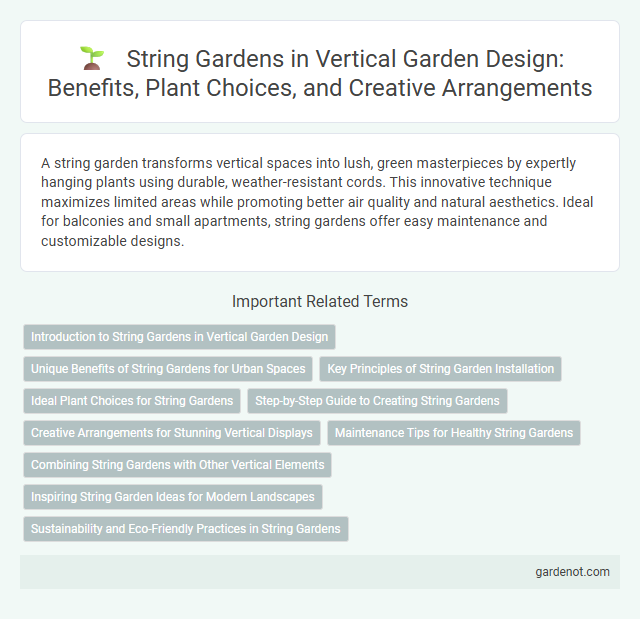A string garden transforms vertical spaces into lush, green masterpieces by expertly hanging plants using durable, weather-resistant cords. This innovative technique maximizes limited areas while promoting better air quality and natural aesthetics. Ideal for balconies and small apartments, string gardens offer easy maintenance and customizable designs.
Introduction to String Gardens in Vertical Garden Design
String gardens revolutionize vertical garden design by utilizing durable cords or wires to support climbing plants and create dynamic green walls. These gardens optimize space in urban environments, promoting air purification and enhancing aesthetic appeal through customizable plant arrangements. Integrating string gardens offers sustainable solutions for vertical greening, encouraging biodiversity and fostering indoor-outdoor connectivity.
Unique Benefits of String Gardens for Urban Spaces
String gardens maximize vertical growing space, ideal for compact urban environments where horizontal land is limited. Their lightweight, modular design allows easy installation on balconies, walls, or fences, enhancing city dwellers' access to fresh herbs and vegetables. This method improves air quality, reduces urban heat, and promotes biodiversity, making string gardens an eco-friendly solution for sustainable urban living.
Key Principles of String Garden Installation
String garden installation emphasizes precise tension and secure anchoring to ensure vertical stability and plant support. Selecting appropriate materials such as UV-resistant strings and corrosion-proof anchors enhances durability and longevity in outdoor environments. Proper spacing between strings allows optimal light exposure and air circulation, promoting healthy plant growth.
Ideal Plant Choices for String Gardens
String gardens thrive with lightweight, trailing plants that adapt well to vertical spaces, such as pothos, philodendrons, and string of pearls. Succulents like burro's tail and creeping jade offer drought tolerance and unique textures ideal for low-maintenance vertical arrangements. Air plants (Tillandsia) also complement string gardens by requiring minimal soil and providing a striking visual contrast.
Step-by-Step Guide to Creating String Gardens
Creating a string garden involves arranging durable, weather-resistant cords vertically on a frame or wall, allowing plants to climb or hang freely. Begin by securing strong anchors or hooks on a sturdy surface, then weave or tie the strings in a grid or pattern tailored to the specific plant species' growth habits. Regularly maintain string tension and monitor plant health to ensure optimal vertical growth and aesthetic appeal in your innovative green space.
Creative Arrangements for Stunning Vertical Displays
String garden designs transform small spaces into vibrant vertical displays by creatively intertwining plants with durable string frameworks. Utilizing moisture-retentive strings and modular hanging systems enhances plant growth while allowing for customizable patterns and shapes. This innovative approach maximizes aesthetic appeal and optimizes space, making it ideal for urban balconies and interior walls.
Maintenance Tips for Healthy String Gardens
Maintaining a healthy string garden requires consistent watering to keep the soil evenly moist but not waterlogged, ensuring adequate indirect sunlight to promote vibrant growth without leaf burn. Regular pruning of the trailing stems prevents overcrowding and encourages bushier foliage, while periodic fertilization with a balanced, water-soluble fertilizer every 4-6 weeks supports nutrient uptake. Monitoring for pests like aphids or spider mites and promptly treating infestations with neem oil or insecticidal soap maintains plant health and vitality.
Combining String Gardens with Other Vertical Elements
String gardens create a dynamic visual impact when combined with other vertical elements such as trellises, living walls, or green screens, enhancing spatial depth and biodiversity. Integrating these components supports diverse plant species, optimizes vertical space, and improves air quality. Using materials with varying textures and colors further enriches the aesthetic appeal and ecological function of the vertical garden.
Inspiring String Garden Ideas for Modern Landscapes
String gardens transform modern landscapes by utilizing vertical planting techniques that maximize space and enhance aesthetic appeal. Integrating drought-resistant plants like succulents and herbs with minimalist string frameworks creates a visually striking and sustainable green wall. These inspiring string garden ideas emphasize clean lines, modular designs, and easy maintenance, making them ideal for urban balconies and compact outdoor areas.
Sustainability and Eco-Friendly Practices in String Gardens
String gardens excel in sustainability by utilizing vertical spaces that reduce soil use and water consumption, promoting efficient resource management. These gardens often incorporate recycled materials such as repurposed fabrics and biodegradable planters, minimizing environmental impact. Integrating native plants in string gardens supports local biodiversity while enhancing air quality and reducing carbon footprint.
String garden Infographic

 gardenot.com
gardenot.com